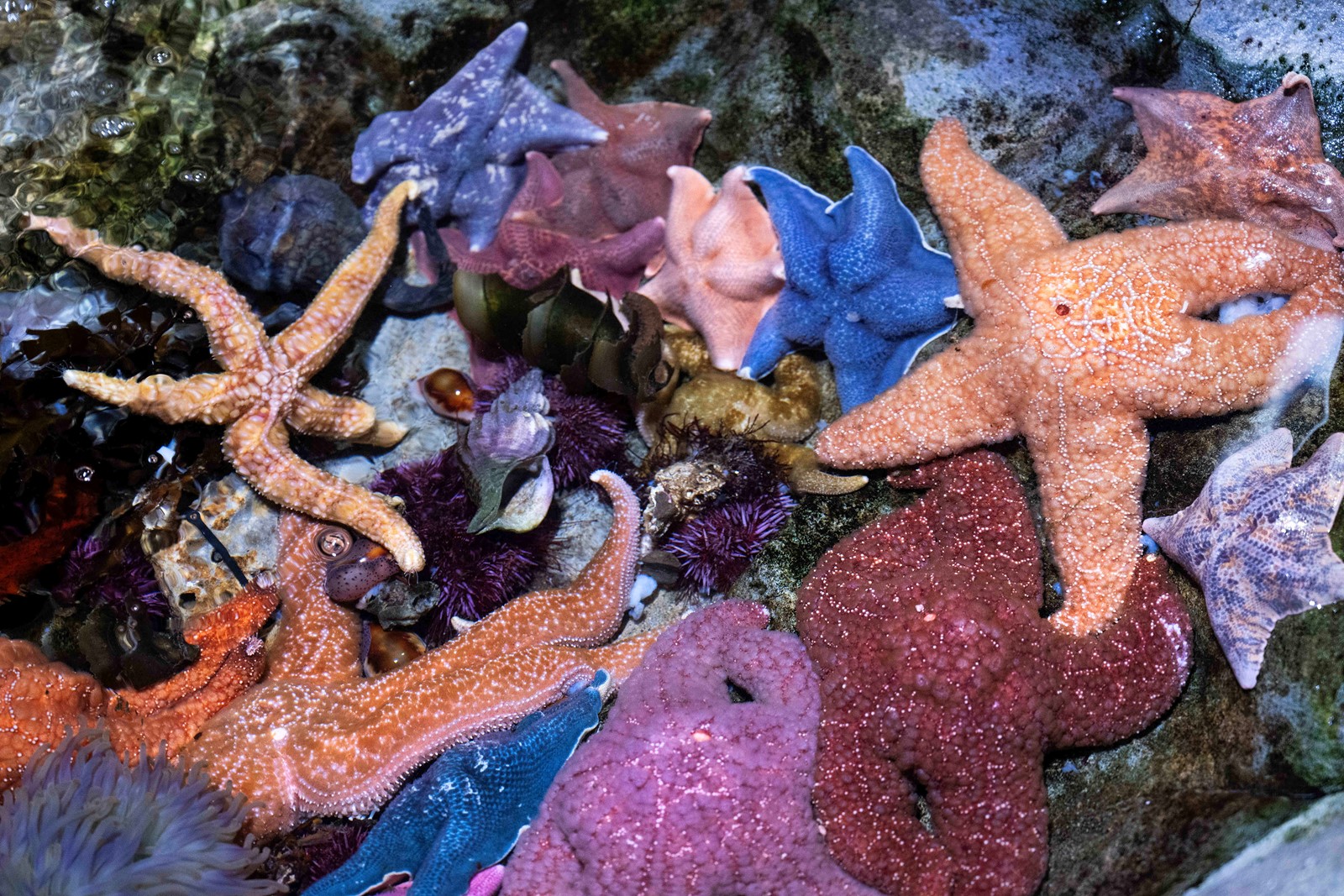

“Our new experience, ‘Stars of the Sea,’ showcases the delicate beauty and superhero abilities of over 20 species of sea stars found in local waters around the globe,” Nate Jaro, the aquarium’s vice president of animal care for fish and invertebrates, said on Wednesday. “You’ll meet sea stars of different sizes, shapes, colors, textures and more, representing diverse habitats, like coastal tide pools, coral reef, the deep sea and beyond.”
Besides showcasing the stars themselves, the aquarium’s new exhibit will also educate visitors about efforts to conserve and protect California’s coastal ecosystem.
One super star that will be featured in the new exhibit is the sunflower sea star, a critically endangered keystone species that is now functionally extinct in California, meaning that its population numbers in the wild are so low, it’s unlikely the creature will be able to recover on its own.
The sunflower sea star, which can live anywhere from 25 to 65 years in the wild and can be up to a meter wide, have historically played a crucial role in balancing California’s coastal ecosystem.
That’s because with up to 24 arms, sunflower sea stars are voracious and carnivorous predators who keep the numbers of other creatures in check.
Historically, one of the sunflower sea star’s many prey in California were sea urchins, Jaros said.
A culmination of several events in 2014 — including an underwater heat wave and an explosion in the sea urchin population — resulted in the destruction of more than 95% of Northern California’s bull kelp forests, according to the National Science Foundation.
Around the same time as the underwater heat wave event, sea stars along the Pacific coast began to die off en masse because of a little-understood condition called sea star wasting disease. Sea star population levels remain low to this day — resulting in a dramatic increase of their natural prey, sea urchins.
“It’s highly contagious, and it affects different stars at different rates. It appears that sunflower stars are one of the most susceptible stars, so they degrade really quickly,” Jaros said. “The disease in the population can come and go, and there’s natural recovery periods — but this most recent event seems to have hit California so hard that recovery on their own may or may not be possible.”
Since that wave of wasting disease hit the sunflower sea star population in California more than a decade ago, Jaros said, no more than a handful of the species have been spotted in local waters.
With the absence of their predators and other factors, sea urchin populations have exploded — contributing, in part, to the continued destruction of California’s kelp forests, which are also crucial to the ecosystem balance.
Satellite images taken by the National Science Foundation in 2021 show that the once plentiful kelp forests along the Northern California coast have been nearly completely replaced by what scientists call sea urchin barren.
“There’s a term that’s been coined called urchin barren — it’s when the ecosystem is devoid of almost all biodiversity, and the only thing that remains are sea urchins,” Jaros said, “to the point where they eat all the food and they have nothing else to eat, and they still don’t die. They just keep living. They digest their reproductive parts. They digest everything, and turn into hollow shells, and they’re just out there.”
But there’s hope for the sunflower sea star, as various conservation groups — including the Aquarium of the Pacific — have joined forces to try to restore the species’ presence in California.
The aquarium is a founding partner of the Association of Zoos and Aquariums’ SAFE sunflower sea star program, which is currently working on the best methodology to breed sunflower stars in aquariums so they can potentially, and eventually, be reintroduced back into the ocean, Jaros said.
“You can’t just breed an animal and throw it out in the ocean, so we’re hoping to expedite this process — because there needs to be a lot of scientific study that goes in hand with releasing animals into the ocean,” Jaros said. “But we’re hoping, in the next few years, that we can overcome those challenges and start to do our part to rebuild those populations.”
The collaboration includes partners from across sectors, including various universities and nonprofits, the California Department of Fish and Wildlife, the National Oceanic Atmospheric Administration, and many other organizations.
Those efforts go hand-in-hand with the aquarium’s initiatives to help conserve and restore California’s kelp forests and other marine ecosystems through the Pacific Coast Ocean Restoration Initiative.
The aquarium currently houses six young sunflower sea stars, which were fertilized on Valentine’s Day last year, earning them the fitting nickname “Cupid’s Cohort.”
“Stars of the Sea” will be on display for nearly a year through April 30.


 PREVIOUS ARTICLE
PREVIOUS ARTICLE
